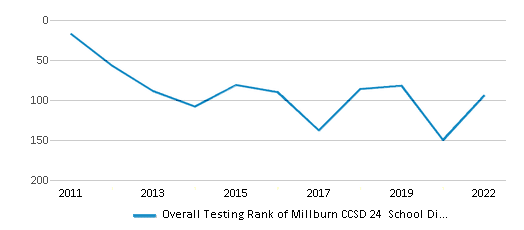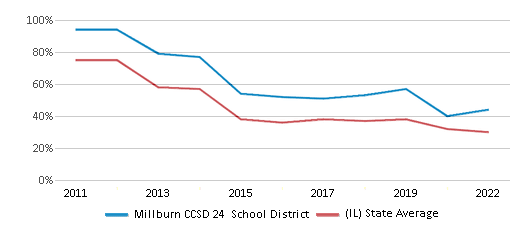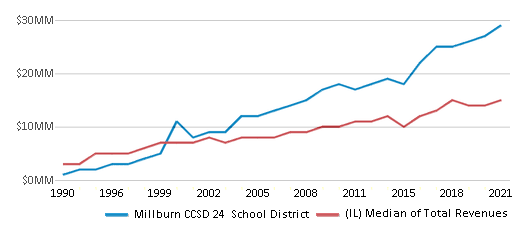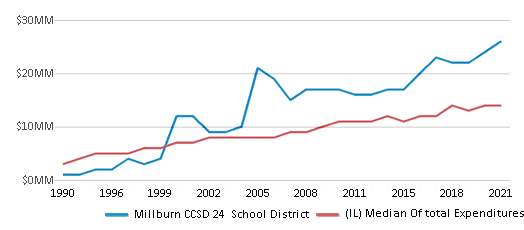Top Rankings
Millburn CCSD 24 School District ranks among the top 20% of public school district in Illinois for:
Category
Attribute
Overall Rank
Highest overall rank (Top 20%)
Math Proficiency
Highest math proficiency (Top 10%)
Reading/Language Arts Proficiency
Highest reading/language arts proficiency (Top 20%)
Science Proficiency
Highest science proficiency (Top 10%)
For the 2025 school year, there is 1 public preschool serving 704 students in Millburn CCSD 24 School District. This district's average pre testing ranking is 9/10, which is in the top 20% of public pre schools in Illinois.
Public Preschool in Millburn CCSD 24 School District have an average math proficiency score of 43% (versus the Illinois public pre school average of 22%), and reading proficiency score of 44% (versus the 25% statewide average).
Minority enrollment is 39% of the student body (majority Hispanic and Asian), which is less than the Illinois public preschool average of 58% (majority Hispanic).
Overview
This School District
This State (IL)
# Schools
2 Schools
1,387 Schools
# Students
1,098 Students
512,005 Students
# Teachers
88 Teachers
38,167 Teachers
Student : Teacher Ratio
12:1
12:1
District Rank
Millburn CCSD 24 School District, which is ranked within the top 20% of all 844 school districts in Illinois (based off of combined math and reading proficiency testing data) for the 2020-2021 school year.
Overall District Rank
#94 out of 852 school districts
(Top 20%)
(Top 20%)

Math Test Scores (% Proficient)
(20-21)48%
28%

Reading/Language Arts Test Scores (% Proficient)
44%
30%

Science Test Scores (% Proficient)
79%
50%
Students by Ethnicity:
Diversity Score
0.56
0.70
# American Indian Students
n/a
1,218 Students
% American Indian Students
n/a
n/a
# Asian Students
139 Students
20,502 Students
% Asian Students
13%
4%
# Hispanic Students
166 Students
162,757 Students
% Hispanic Students
15%
32%
# Black Students
46 Students
94,002 Students
% Black Students
4%
18%
# White Students
694 Students
213,555 Students
% White Students
63%
42%
# Hawaiian Students
n/a
447 Students
% Hawaiian Students
n/a
n/a
# Two or more races Students
52 Students
19,465 Students
% of Two or more races Students
5%
4%
Students by Grade:
# Students in PK Grade:
35
76,065
# Students in K Grade:
99
71,052
# Students in 1st Grade:
103
68,700
# Students in 2nd Grade:
108
66,332
# Students in 3rd Grade:
109
56,657
# Students in 4th Grade:
133
53,643
# Students in 5th Grade:
117
46,874
# Students in 6th Grade:
130
28,049
# Students in 7th Grade:
133
22,127
# Students in 8th Grade:
131
22,424
# Students in 9th Grade:
-
40
# Students in 10th Grade:
-
12
# Students in 11th Grade:
-
12
# Students in 12th Grade:
-
18
# Ungraded Students:
-
-
District Revenue and Spending
The revenue/student of $26,711 is higher than the state median of $21,990. The school district revenue/student has stayed relatively flat over four school years.
The school district's spending/student of $23,838 is higher than the state median of $21,244. The school district spending/student has stayed relatively flat over four school years.
Total Revenue
$29 MM
$41,381 MM

Spending
$26 MM
$39,976 MM

Revenue / Student
$26,711
$21,990

Spending / Student
$23,838
$21,244

Best Millburn CCSD 24 School District Public Preschools (2025)
School
(Math and Reading Proficiency)
(Math and Reading Proficiency)
Location
Grades
Students
Rank: #11.
Millburn Elementary School
Rank:
9/
Top 20%10
18550 W Millburn Rd
Wadsworth, IL 60083
(847) 356-8331
Wadsworth, IL 60083
(847) 356-8331
Grades: PK-5
| 704 students
Recent Articles

Year-Round Or Traditional Schedule?
Which is more appropriate for your child? A year-round attendance schedule or traditional schedule? We look at the pros and cons.

Why You Should Encourage Your Child to Join a Sports Team
Participating in team sports has a great many benefits for children, there is no doubt. In this article you will learn what those benefits are.

White Students are Now the Minority in U.S. 九游体育s
Increasing birth rates among immigrant families from Asia and Central and South America, combined with lower birth rates among white families, means that for the first time in history, public school students in the United States are majority-minority. This shift in demographics poses difficulties for schools as they work to accommodate children of varying language abilities and socio-economic backgrounds.





